The $350 million Long Beach Civic Center is a state-of-the-art facility that provides the City and Port of Long Beach, California, with performance-based infrastructure commensurate with its size and status as a world-class shipping and logistics hub. The City wanted a revitalized civic core that was environmentally sustainable and resilient. The project was developed under a public-private partnership (PPP) with developer Plenary-Edgemoor Civic Partners and general contractor Clark Construction. The design was led by Skidmore, Owings, and Merrill (SOM) as the architect, and structural engineering was shared by Nabih Youssef Associates Structural Engineers (NYASE) and SOM.
The project includes a new eleven-story 247,000-square-foot City Hall tower, eleven-story 238,300-square-foot Port Headquarters tower, and single-story elliptical-shaped City Hall Council Chambers. All three buildings sit on top of a standard two-story 217,400-square-foot subterranean parking garage.
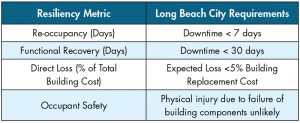
Building Description
The City Hall and Port Headquarters towers are rectangular with an approximate overall dimension of 275 feet by 85 feet at the typical floor. The floors have flat-plate 10-inch-thick post-tensioned concrete slabs with exposed soffits. Due to architectural constraints, portions of the floor slabs at both towers have large cantilevers that required creative design solutions to maintain the aesthetic of the flat slab. This condition occurred at all corners of the building above the third floor and in the middle of the building, where the second-floor slab was recessed off the column line to create a two-story-tall entry. The 16.5-foot cantilevers at the corners of the building were addressed by utilizing upturned post-tensioned beams within the depth of the access flooring system to keep the beams hidden and maintain the architectural integrity. The second floor recessed floor slab at the entry, which would have resulted in a 17.5-foot-long cantilever, was addressed by adding hanger columns supporting the edge of slab from beams located at the third floor, which successfully achieved the desired architectural aesthetic.
Resilient Building Design
A standard code-based design approach uses prescriptive design requirements that protect the building’s occupants during a design-level seismic event. However, it does not ensure that the building can be re-occupied after a seismic event or even that repairs to the building are economical.
Resilient building design goes beyond the prescriptive objectives in the building code and focuses on the ability to recover from a large seismic event quickly. The Federal Emergency Management Agency (FEMA) developed a methodology and approach to assessing the probable seismic performance of a building, published in 2012 as FEMA P-58, Seismic Performance Assessment of Buildings, Methodology, and Implementation. FEMA P-58 provides a foundation for the ongoing evolution of resilient building design.
The City of Long Beach adopted the Resilience-based Earthquake Design Initiative (REDi™) rating system developed by Arup and specified REDi Gold as a project performance objective. In addition to life safety, the objectives include a 50% probability that the re-occupancy time will not exceed seven days, the functional recovery time will not exceed thirty days, and the repair costs will be less than five percent of the replacement cost of the building after a design level earthquake.
The SP3 software based on FEMA P-58 and developed by Haselton Baker Risk Group was used throughout the design process to assess conformance with project performance objectives. In addition, the final design was peer-reviewed by Arup for compliance with REDi Gold.
Structural Design Solutions
The seismic design was performed using linear dynamic analysis following the requirements of ASCE 7, Minimum Design Loads and Associated Criteria for Buildings and Other Structures. In addition to the code-based design analysis, a nonlinear time history analysis was performed to demonstrate compliance with the resilient-based design objective. Unlike performance-based design approaches commonly used in high-rise design, the approach outlined in the REDi rating system focuses on a life safety objective at the design level earthquake. It does not explicitly evaluate performance at the maximum considered design earthquake.
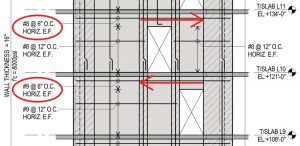
Both the City Hall and Port Headquarters towers have two C-shaped special reinforced concrete shear walls at opposite ends of the building. The conventional approach of using stacked wall openings in the shear walls was initially utilized to create coupling beams at every floor. However, even under a modest inter-story drift, the rotational demand on these beams resulted in extensive cracking and spalling, leading to long repair times.
Through extensive collaboration with SOM architects and engineers, staggering the wall openings at each floor was developed to eliminate the coupling beams that were susceptible to damage. However, this created new design challenges, with wall piers changing length at every floor. A portion of the wall shear force needed to be dragged between the openings using additional horizontal reinforcement in the walls that were concentrated between the openings. This unusual load path was seen in the wall shear stress results from the nonlinear analysis and verified using strut and tie models.
Results from the nonlinear time history analysis also indicated much higher shear demands in the walls, due to higher mode effects, than what was indicated by the linear analysis. Although currently codified in ACI 318-19, this phenomenon was, at the time, not commonly accounted for in midrise building design.
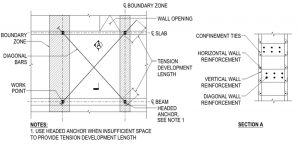
Special detailing was utilized at the base of the C-shaped core walls (i.e., two stories above grade), where hinging is most likely to occur due to flexural yielding in the wall. This included providing seismic ties at all vertical reinforcement throughout the length of the wall to prevent bar buckling due to large peak strains in the reinforcement. Diagonal shear reinforcement was also provided in the shear wall piers at the base of the wall, similar to the diagonal reinforcement commonly used in coupling beams, to supplement the standard horizontal shear reinforcement. This unique approach was developed and tested by Paulay, Priestley, and Synge and shown to be effective in resisting diagonal tension and compression stresses due to shear demands in concrete shear walls. The horizontal shear reinforcement was designed to resist the code-level shear forces, and the diagonal shear reinforcement was designed to resist the shear forces from higher mode effects.
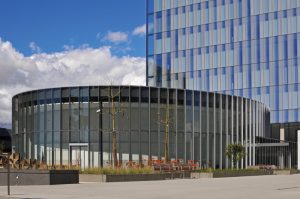
Due to the higher Risk Category III designation, the City Hall Council Chambers building was seismically separated from the City Hall tower. Early in the design, steel moment frames were considered for use as the lateral force-resisting system; however, due to large residual drifts, it was deemed unsuitable for achieving REDi Gold. Ultimately, steel braced frames were selected and designed to remain elastic in the design level earthquake to limit residual drifts.
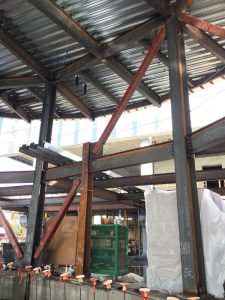
Nonstructural Components
A defining aspect of resilience-based design is the emphasis on assessing the seismic performance of nonstructural components. These components are influenced by the response of a building during an earthquake (inter-story drifts and floor accelerations). For example, a building that is too stiff increases seismic floor accelerations and forces on bracing and anchorage of mechanical and electrical components. At the same time, a building that is too flexible leaves partition walls, exterior façade elements, and stairs vulnerable to damage. An iterative design process found that a one percent inter-story drift target provided the right balance between limiting bracing and anchorage forces while also protecting partition walls, exterior façades, and stairs.
Anchorage and bracing mechanical and electrical components with large lead times were designed using a maximum component response modification factor (Rp) of 2 to keep these components “essentially elastic.” Mission-critical components were required to be tested on a shake table to demonstrate operability after a design-level seismic event. One elevator per building was designed with an Rp of 1 to remain operational after a seismic event. Guide rail supports and retainer plates were designed using California Office of Statewide Health Planning and Development requirements.
The exterior façade was designed and tested in a lab to ensure the system would remain effective at preventing air and water intrusion at the design seismic drift and that no catastrophic failures would occur at twice the design seismic drift. In addition, egress stairs were detailed with a sliding connection at one end to accommodate twice the design seismic drift to ensure life safety after a large seismic event.
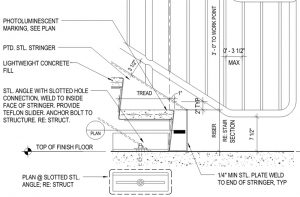
Summary
The Long Beach Civic Center was completed in the summer of 2019 and stands as a visual representation of resilient building design. Innovative engineering solutions and invaluable collaboration led to the ultimate success of the project.■
